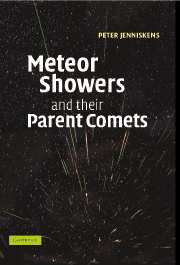Book contents
- Frontmatter
- Dedication
- Contents
- Preface
- Acknowledgements
- Part I Introduction
- 1 How meteor showers were linked to comets
- 2 What is at the core of comets?
- 3 The formation of meteoroid streams
- 4 Meteors from meteoroid impacts on Earth
- 5 Comet and meteoroid orbits
- Part II Parent bodies
- Part III Young streams from water vapor drag
- Part IV Young streams from comet fragmentation
- Part V Old streams and sporadic meteoroids
- Part VI Impact and relevance of meteor showers
- Appendix
- Tables
- Index
- Units and constants
2 - What is at the core of comets?
from Part I - Introduction
Published online by Cambridge University Press: 05 July 2015
- Frontmatter
- Dedication
- Contents
- Preface
- Acknowledgements
- Part I Introduction
- 1 How meteor showers were linked to comets
- 2 What is at the core of comets?
- 3 The formation of meteoroid streams
- 4 Meteors from meteoroid impacts on Earth
- 5 Comet and meteoroid orbits
- Part II Parent bodies
- Part III Young streams from water vapor drag
- Part IV Young streams from comet fragmentation
- Part V Old streams and sporadic meteoroids
- Part VI Impact and relevance of meteor showers
- Appendix
- Tables
- Index
- Units and constants
Summary
The most spectacular result of recent space missions to comets has been to show the spring of meteoroid streams, first when Giotto visited Halley in 1986. The return of comet Halley was highly anticipated. I was an undergraduate student of astronomy at Leiden University in the Netherlands and was invited to be a tour guide on a chartered DC-9 airplane to watch the comet above the usual deck of clouds. Two hundred people eager to see the scourge of legend sparkle in the sky paid $50 and were given six ten-minute laps over the North Sea, each time providing a new group a seat at the windows. I recall spending some extra time with an eyewitness of comet Halley's previous return in 1910. She had the gray hair and worn face of one outlasting Halley's 76 yr orbit. Sadly, her eyesight had suffered over the years and she never found the faint +4m fuzz of light in the constellation of Capricorn. She was thrilled nonetheless. This was her first time in a plane, and my first astronomical expedition.
The word comet comes from the Greek ĸομετεσ = “the hairy one.” The Chinese astronomers called these objects hui or “broomstars” and tracked their position in the constellations, moving from one group of stars to the next over days or sometimes many weeks on account of their great distances. From a distance, these inferior planets of our solar system are fuzzy blobs, sometimes with a diffuse tail pointing away from the Sun. Prior to AD 1577, comets and shooting stars were all considered meteors (Fig. 2.1). Even today, popular culture does not always make the correct distinction between comets, the minor planets in space, and the meteors caused by their debris impacting on Earth's atmosphere.
Danish astronomer Tycho Brahe (1546–1601) first proved that comets belong in the realm of astronomy by demonstrating from the lack of parallax between viewing the comet in the evening and the morning that the bright comet of 1577 was at least four times farther from Earth than the Moon.
Information
- Type
- Chapter
- Information
- Meteor Showers and their Parent Comets , pp. 12 - 27Publisher: Cambridge University PressPrint publication year: 2006
